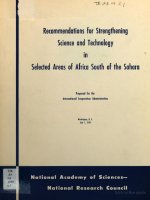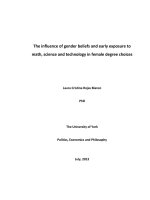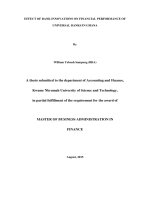Science and technology in world history
Bạn đang xem bản rút gọn của tài liệu. Xem và tải ngay bản đầy đủ của tài liệu tại đây (13.85 MB, 491 trang )
Science and
Technology in
World History
This page intentionally left blank
Science and
Technology in
World History
AN INTRODUCTION
Second Edition
James E. McClellan III
and Harold Dorn
THE JOHNS HOPKINS UNIVERSITY PRESS
Baltimore
© 2006 The Johns Hopkins University Press
All rights reserved. Published 2006
Printed in the United States of America on acid-free paper
9 8 7 6 5 4 3 2 1
The Johns Hopkins University Press
2715 North Charles Street
Baltimore, Maryland 21218-4363
www.press.jhu.edu
Library of Congress Cataloging-in-Publication Data
McClellan, James E. (James Edward), 1946–
Science and technology in world history : an introduction / James E. McClellan
III and Harold Dorn.—2nd ed.
p.
cm.
Includes bibliographical references and index.
isbn 0-8018-8359-8 (acid-free paper)—isbn 0-8018-8360-1 (pbk. : acid-free
paper)
1. Science—History. 2. Technology—History. 3. Tool and die makers—
History. I. Dorn, Harold, 1928– . II. Title.
q125.m414 2006
509—dc22
2005027399
A catalog record for this book is available from the British Library.
Contents
Preface
INTRODUCTION.
PA R T I .
vii
The Guiding Themes
1
From Ape to Alexander
3
CHAPTER 1.
Humankind Emerges: Tools and Toolmakers
CHAPTER 2.
The Reign of the Farmer
17
CHAPTER 3.
Pharaohs and Engineers
31
CHAPTER 4.
Greeks Bearing Gifts
55
CHAPTER 5.
Alexandria and After
79
PA R T I I .
Thinking and Doing among the
World’s Peoples
97
CHAPTER 6.
The Enduring East
CHAPTER 7.
The Middle Kingdom
CHAPTER 8.
Indus, Ganges, and Beyond
CHAPTER 9.
The New World
PA R T I I I .
99
117
141
155
Europe and the Solar System
175
CHAPTER 10.
Plows, Stirrups, Guns, and Plagues
CHAPTER 11.
Copernicus Incites a Revolution
CHAPTER 12.
The Crime and Punishment of Galileo Galilei
CHAPTER 13.
“God said, ‘Let Newton be!’”
PA R T I V.
5
177
203
249
Science and Industrial Civilization
CHAPTER 14.
Timber, Coal, Cloth, and Steam
CHAPTER 15.
Legacies of Revolution
295
279
275
223
CHAPTER 16.
Life Itself
CHAPTER 17.
Toolmakers Take Command
CHAPTER 18.
The New Aristotelians
CHAPTER 19.
The Bomb and the Genome
CHAPTER 20.
Under Today’s Pharaohs
415
CONCLUSION.
The Medium of History
437
441
Illustration Credits
463
CONTENTS
465
339
365
Guide to Resources
Index
vi
323
391
Preface
This book was written as an introduction for general readers and
undergraduate students to provide the “big picture” that an educated
person might wish to have of the history of science and technology. It
was not written for scholars or experts, and its character as a textbook
is self-evident. The style and format grew out of our extensive experience in engaging undergraduates in these matters, and the hard knocks
of the classroom have suggested both the essential lessons and the
materials and examples that work well in conveying those lessons.
The success of the first edition of this work exceeded our expectations and hopes. The book has been widely adopted at the college level
in history of science and technology courses, and also in courses devoted to world civilization and modernization. To judge from correspondence sent to us, the first edition of this book has been well received by a lay public beyond the walls of the university, evidently
attracted by its broad subject. And, a surprise to us, it has also been
translated into Chinese, German, Turkish, and now Korean. Undoubtedly, what appeals to foreign publishers and readers was foreshadowed
in our title, which reflects our vision for this book: Science and Technology in World History.
We are gratified by the reception our work has received, and we are
grateful for the opportunity to craft a revised edition. In the present
version we have corrected several small errors that crept into the first
edition, and we have introduced a few stylistic changes that we hope
improve the clarity of our presentation and prose. We have also used
this occasion to divide the previous single chapter on Greek science
into two. These separate chapters are now more in proportion with the
others in the book, and the division helps to underscore the distinction
between the Hellenic and Hellenistic periods in the history of ancient
Greek science, a distinction of fundamental analytical significance to
our presentation.
These changes aside, the major modifications we have introduced in
this edition center on the last part of the book, part 4, and on expanded
treatments of technological systems and applied science in the twentieth and now twenty-first centuries. In retrospect, although all the
themes were present in the first edition, our narrative concerning more
recent history of science and technology was comparatively thin. We
hope to have rectified this shortcoming by exploring in greater depth
and detail the technological and applied-science underpinnings of industrial civilization today. In particular, regarding contemporary technology, in the present chapter 17, in addition to the automobile industry, we expand our treatment to include electrification, aviation, domestic
technologies, and entertainment industries. Regarding applied science
today, in a new chapter 19, in addition to a discussion of the atomic
bomb, we delve further into medical technologies, genetics, computers,
and communication technologies, and we examine more systematically
the concept of applied science. Finally, in our concluding chapter we
have augmented our treatment of science as a social institution in today’s world. In making these revisions, we have likewise sought to place
greater emphasis on industrial civilization itself and on modern science
and technology as distinctive traits of globalization.
Between the appearance of the first and second editions of this book,
the world passed from the twentieth to the twenty-first century. Leaving aside historical and historiographical changes occurring in the interval that we needed to take into account, this millennial passage produced two minor effects that surprised us as we prepared this new
edition. One concerned style, as we had to change from the present
tense to the past tense in writing about the late stages of the twentieth
century. The other effect was psychological. In the first edition, we realize now, our perspective on the twentieth-century present in which we
were writing was backward-looking and decidedly fin de siècle. Now
that the world has crossed into the third millennium of the common
era, we find that we are taking a more forward-looking stance toward
our own day and the period ahead. That shift in viewpoint does not
make us more optimistic, however.
The preface to the first edition acknowledged the people and institutions that aided us in producing that work, and it is unnecessary to
repeat those thanks at this remove. Here, we would express our gratitude to the several readers who noted errors in the first edition and who
made suggestions for improvements, notably our colleague Prof. Robert
Packard and especially Prof. Edith Sylla of North Carolina State University, who was so gracious and tactful in communicating with the
authors. We thank Mr. Colin Daly of the Scilly Isles, UK, for his communication, and we are pleased also to recognize several friends and
colleagues who read and vetted new material for this revised edition,
and in this regard our thanks go out to Dr. Hartmut Krugmann, Ms.
Kristina Larson, Dr. Philip R. Reilly, Professor Susan Schept, and Prof.
viii
P R E FA C E
David Vaccari. Two anonymous referees offered useful advice for polishing the new material. Our students at Stevens Institute of Technology were once again critical readers, and we acknowledge their many
suggestions for enhancing the presentation. Bits and pieces of several
student research projects have found their way into the present work,
and in particular, we thank Mr. Alessandro Civic and sections of our
history of science and technology survey course for helping us update
and vet the new list of Internet resources accompanying our text. We
are grateful to Dr. Robert J. Brugger and his associates at the Johns
Hopkins University Press. As they were in the initial publication, they
have been more than supportive of this effort, and their professionalism and effectiveness are again manifest in the physical object at hand.
Many years ago, Miriam Selchen Dorn first suggested that the two
of us write a book together on the history of science and technology.
Jackie McClellan, along the way and over the years as the first and
now revised edition of this work has taken shape, has been a steadfast
reader and editor. The authors are pleased to use this opportunity to
salute their wives.
P R E FA C E
ix
This page intentionally left blank
Science and
Technology in
World History
This page intentionally left blank
INTRODUCTION
The Guiding Themes
The twentieth century witnessed a fateful change in the relationship
between science and society. In World War I scientists were conscripted
and died in the trenches. In World War II they were exempted as
national treasures and committed to secrecy, and they rallied behind
their country’s war effort. The explanation of the change is not hard to
find—governments came to believe that theoretical research can produce practical improvements in industry, agriculture, and medicine.
That belief was firmly reinforced by developments such as the discovery of antibiotics and the application of nuclear physics to the production of atomic weapons. Science became so identified with practical
benefits that the dependence of technology on science is commonly
assumed to be a timeless relationship and a single enterprise. Science
and technology, research and development—these are assumed to be
almost inseparable twins. These rank among the sacred phrases of our
time. The belief in the coupling of science and technology is now petrified in the dictionary definition of technology as applied science, and
journalistic reports under the rubric of “science news” are, in fact,
often accounts of engineering rather than scientific achievements.
That belief, however, is an artifact of today’s cultural attitudes superimposed without warrant on the historical record. Although the historical record shows that in the earliest civilizations under the patronage of pharaohs and kings, and in general whenever centralized states
arose, knowledge of nature was exploited for useful purposes, it cannot be said that science and technology were systemically and closely
related. By the same token, in ancient Greece (where theoretical science
had its beginning), among the scholastics of the Middle Ages, in the
time of Galileo and Newton, and even for Darwin and his contemporaries in the nineteenth century, science constituted a learned calling
whose results were recorded in scientific publications, while technology was understood as the crafts practiced by unschooled artisans.
Until the second half of the nineteenth century few artisans or engineers
attended a university or, in many cases, received any formal schooling
at all. Conversely, the science curriculum of the university centered
largely on pure mathematics and what was often termed natural philosophy—the philosophy of nature—and was written in technical terms
(and often language) foreign to artisans and engineers.
In some measure, the wish engenders the thought. Science has undoubtedly bestowed genuine benefits on humankind, and it has fostered the hope that research can be channeled in the direction of social
utility. But a more secure understanding of science, one less bound by
the cultural biases of our time, can be gained by viewing it through the
lens of history. Seen thus, with its splendid achievements but also with
its blemishes and sometimes in an elitist posture inconsistent with our
democratic preferences, science becomes a multidimensional reality
rather than a culture-bound misconception. At the same time, a more
accurate historical appreciation of technology will place proper emphasis on independent traditions of skilled artisans whose talents crafted
everyday necessities and amenities throughout the millennia of human
existence. Such a historical reappraisal will also show that in many
instances technology directed the development of science, rather than
the other way around.
In order to develop the argument that the relationship between science and technology has been a historical process and not an inherent
identity, in this book we trace the joint and separate histories of science
and technology from the prehistoric era to the present. We intend to
review the common assumption that technology is applied science and
show, instead, that in most historical situations prior to the twentieth
century science and technology have progressed in either partial or full
isolation from each other—both intellectually and sociologically. In
the end, an understanding of the historical process will shed light on
the circumstances under which science and technology have indeed
merged over the past hundred years.
2
INTRODUCTION
PART I
From Ape to Alexander
Technology in the form of stone tools originated literally hand in hand
with humankind. Two million years ago a species of primate evolved
which anthropologists have labeled Homo habilis, or “handy man,” in
recognition of its ability, far beyond that of any other primate, to fashion tools. Over the next 2,000 millennia our ancestors continued to
forage for food, using a toolkit that slowly became more elaborate and
complex. Only toward the end of that long prehistoric era did they
begin to observe the natural world systematically in ways that appear
akin to science. Even when a few communities gave up the foraging
way of life, around 12,000 years ago, in favor of farming or herding
and developed radically new tools and techniques for earning a living,
they established societies that show no evidence of patronizing scientists or fostering scientific research. Only when civilized—city-based—
empires emerged in the ancient Near East did monarchs come to value
higher learning for its applications in the management of complex
societies and found institutions for those ends. The ancient Greeks
then added natural philosophy, and abstract theoretical science took
its place as a component of knowledge. An account of these developments forms the subject matter of part 1.
This page intentionally left blank
CHAPTER 1
Humankind Emerges:
Tools and Toolmakers
Scholars customarily draw a sharp distinction between prehistory and
history. Prehistory is taken to be the long era from the biological beginnings of humankind over 2 million years ago to the origins of civilization about 5,000 years ago in the first urban centers of the Near East.
The transition to civilization and the advent of written records traditionally mark the commencement of history proper.
Prehistory, because of the exclusively material nature of its artifacts,
mainly in the form of stone, bone, or ceramic products, has inescapably
become the province of the archaeologist, while the historical era, with
its documentary records, is the domain of the historian. However, the
single label “prehistory” obscures two distinctly different substages:
the Paleolithic, or Old Stone Age, which held sway for around 2 million years, is marked by rudimentary stone tools designed for collecting and processing wild food sources, while the succeeding Neolithic,
or New Stone Age, which first took hold in the Near East around
12,000 years ago, entailed substantially more complex stone implements adapted to the requirements of an economy of low-intensity food
production in the form of gardening or herding.
The technologies of both the Paleolithic and Neolithic eras have left
a rich legacy of material artifacts. In contrast, only a feeble record
exists of any scientific interests in these preliterate societies, mainly in
the form of astronomically oriented structures. Thus, at the very outset, the evidence indicates that science and technology followed separate trajectories during 2,000 millennia of prehistory. Technology—the
crafts—formed an essential element of both the nomadic food-collecting economy of Paleolithic societies and the food-producing activities
in Neolithic villages, while science, as an abstract and systematic interest in nature, was essentially nonexistent, or, at any rate, has left little
trace.
The Arrival of Handyman
By most accounts human beings appeared on Earth only recently, as
measured on the scales of cosmic, geologic, or evolutionary time. As
scientists now believe, the cosmos itself originated with the “Big Bang”
some 12 to 15 billion years ago. Around 4 billion years ago the earth
took shape as the third in a string of companion planets to an ordinary
star near the edge of an ordinary galaxy; soon the self-replicating chemistry of life began. Biological evolution then unfolded over the next millions and billions of years. In the popular imagination the age of the
dinosaurs exemplifies the fantastic history of life in past ages, and the
catastrophic event—probably a comet or an asteroid colliding with the
earth—that ended the dinosaur age 65 million years ago illustrates the
vicissitudes life suffered in its tortuous evolution. The period that followed is known as the age of mammals because these animals flourished and diversified in the niche vacated by the dinosaurian reptiles.
By about 4 million years ago a line of “ape-men” arose in Africa—the
australopithecines—our now-extinct ancestral stock.
Figure 1.1 depicts the several sorts of human and prehuman species
that have arisen over the last 4 million years. Experts debate the precise
evolutionary paths that join them, and each new fossil discovery readjusts the details of the story; yet its broad outlines are not in dispute.
The figure shows that anatomically modern humans, Homo sapiens
sapiens, or the “wise” variety of “wise Man,” evolved from a series of
human and prehuman ancestors. Archaic versions of modern humans
made their appearance after about 500,000 years ago, with the Neanderthals being an extinct race of humans that existed mainly in the cold
of Europe between 135,000 and 35,000 years ago. Scholars differ over
the modernity of Neanderthals and whether one would or would not
stand out in a crowd or in a supermarket. Many scientists look upon
them as so similar to ourselves as to form only an extinct variety or
race of our own species, and so label them Homo sapiens neanderthalensis. Others think Neanderthals more “brutish” than anatomically modern humans and therefore regard them as a separate species,
Homo neanderthalensis.
Preceding Homo sapiens, the highly successful species known as
Homo erectus arose around 2 million years ago and spread throughout the Old World (the continents of Africa, Europe, and Asia). Before
that, the first species of human being, Homo habilis, coexisted with at
least two other species of upright hominids, the robust and the gracile
forms of the species Paranthropus. At the beginning of the sequence
stood the ancestral genus Australopithecus (or “Southern Ape”) that
includes Australopithecus afarensis—represented by the fossil “Lucy.”
This sequence highlights several points of note. First is the fact of
human evolution, that we arose from more primitive forebears. Among
the more significant indicators of this evolution is a progression in brain
6
FROM APE TO ALEXANDER
size, from around 450 cubic centimeters (cc) in the case of prehuman
Lucy, only slightly larger than the brain of a modern chimpanzee,
through an average of 750 cc for Homo habilis, 1000 cc for Homo
erectus, to around 1400 cc for humanity today. An as-yet-unexplained
irony of this “progression” is that Neanderthals had slightly larger
brains than today’s humans.
Bipedality—or walking upright on two feet—represents another defining feature of this evolutionary sequence. Experts debate whether
Lucy and her kin were fully bipedal, but her successors certainly were.
An upright stance allows the hand and arm to become a multipurpose
utensil for grasping and carrying items. Lucy and her type had probably adopted male-female cooperation, at least temporary pair-bonding, and a “family” structure for raising offspring.
From the point of view of the history of technology, however, the
most important lesson to be drawn from figure 1.1 concerns tool use
among our ancestors. It used to be thought that tool use—technology—
HUMANKIND EMERGES
Fig. 1.1. Human evolution. Modern humans
(Homo sapiens sapiens)
evolved from earlier, now
extinct, human and prehuman ancestors. (Plants
and animals are classified
according to the binomial
nomenclature of genus
and species: genus being
general groups of related
species, and species being
specific interbreeding
populations of individuals. Thus, Homo is the
genus, and sapiens the
species; the third name
indicates a subspecies.) In
general, brain size and
technological sophistication increased over time,
but there is no strict correlation between species
and technologies. For
example, Paranthropus
and Homo habilis may
both have used simple
choppers; H. erectus and
archaic H. sapiens cannot
be distinguished by their
respective fine-blade
tool kits. Aspects of this
picture are matters of
debate, notably the relationship of Neanderthals
to modern humans. New
findings regularly shed
new light on the details of
human biological and cultural evolution.
7
is an exclusively human characteristic; the oldest fossil of the human
genus, Homo habilis, received its name (“handy man”) both because
of its “human” skeletal features and because it was discovered along
with simple stone choppers. However, the older notion can no longer
be maintained. Indeed, the origin of technology is rooted in biology.
Some nonhuman animals create and use tools, and technology as a cultural process transmitted from generation to generation arises occasionally among monkey and ape communities. Chimpanzees in the wild
sometimes “fish” for termites by carefully preparing a twig, inserting
it into a termite nest, and licking off the insects that cling to it. Since
the activity is not instinctive but is instead taught to juveniles by their
mothers, it must be regarded as cultural, unlike, say, the instinct of bees
to build hives. Reportedly, chimpanzees have also culturally transmitted knowledge of medicinal plants, so it may be possible to identify
the origins of medical technology outside of the human genus, too. Perhaps the best documented feats of technical innovation and cultural
transmission in the animal world concern a single female, Imo, the
“monkey genius” of a colony of Japanese macaques. Incredibly, Imo
made two separate technical discoveries. First she discovered that to
remove sand from potatoes thrown on the beach she could wash them
in the sea rather than pick off the sand with her fingers. Then, in an
even more remarkable display of ingenuity, Imo found that to separate
rice from sand she did not have to pick out the individual grains; the
mixture can be dropped into water where the sand will sink, and the
rice will float and can be easily recovered. Both techniques were adopted
by younger members of the troop as well as by older females and passed
on to the next generation.
Claims have been made that not only Homo habilis but also species
of Paranthropus probably made stone implements and may have used
fire. Furthermore, little correlation exists between species type and different types of toolkits. For example, Neanderthal tools varied little
from the precedents set by Homo erectus. The record reveals only a
weak correlation between biological species and the toolkit used.
That said, however, making and using tools and the cultural transmission of technology became essential to the human mode of existence
and was practiced in all human societies. Moreover, humans seem to
be the only creatures who fashion tools to make other tools. Without
tools humans are a fairly frail species, and no human society has ever
survived without technology. Humankind owes its evolutionary success in large measure to mastery and transmission of toolmaking and
-using, and thus human evolutionary history is grounded in the history
of technology.
Control of fire represented a key new technology for humankind.
Fire provided warmth. Fire made human migration into colder climes
possible, opening up huge and otherwise inhospitable areas of the
globe for human habitation. The technology of fire also supplied arti8
FROM APE TO ALEXANDER
ficial light, thus extending human activity after dark and into dark
places, such as caves. Fire offered protection against wild animals. Fire
permitted foods to be cooked, which lessened the time and effort required to eat and digest meals. Fire-hardened wooden tools became
possible. And fire no doubt served as a hearth and a hub for human
social and cultural relations for a million years. Their practical knowledge of fire gave early humans a greater degree of control over nature.
Homo erectus was an exceptionally successful animal, at least as measured by its spread across the Old World from Africa to Europe, Asia,
Southeast Asia, and archipelagoes beyond. That success in large measure depended on mastering fire.
The grasping hand constitutes one human “tool” that evolved through
natural selection; speech is another. Speech seems to be a relatively
recent acquisition, although paleontologists have not yet reached agreement on how or when it first appeared. Speech may have evolved from
animal songs or calls; novel brain wiring may have been involved. But,
once acquired, the ability to convey information and communicate in
words and sentences must have been an empowering technology that
produced dramatic social and cultural consequences for humanity.
A turning point occurred around 40,000 years ago. Previously, Neanderthals and anatomically modern humans had coexisted for tens of
thousands of years in the Middle East and in Europe. Around 35,000
years ago Neanderthals became extinct, possibly exterminated through
conflict with a new population, or they may have interbred and become
absorbed into the modern human gene pool. A cultural discontinuity
manifested itself around the same time. Whereas Neanderthals had produced simple, generalized, multipurpose tools from local materials,
we—Homo sapiens sapiens—began to produce a great assortment of
tools, many of which were specialized, from stone, bone, and antler:
needles and sewn clothing, rope and nets, lamps, musical instruments,
barbed weapons, bows and arrows, fish hooks, spear throwers, and
more elaborate houses and shelters with fireplaces. Humans began to
conduct long-distance trade of shells and flints through exchange over
hundreds of miles, and they produced art, tracked the moon, and buried
their dead. And yet, in terms of their basic social and economic way of
life, they continued along the same path—they remained nomadic foodcollectors.
Foraging for a Living
Prehistorians classify the period from 2 million years ago to the end of
the last Ice Age at about 12,000 years ago as a single era. They label it
the Paleolithic (from the Greek, paleo, “ancient”; lithos, “stone”) or
Old Stone Age. Food-collecting is its essential attribute, codified in the
term hunter-gatherer society. Paleolithic tools aided in hunting or scavenging animals and for collecting and processing plant and animal food,
HUMANKIND EMERGES
9
Fig. 1.2. “H. erectus
Utilizing a Prairie Fire,”
by Jay H. Matternes.
Control of fire became a
fundamental technology
in the human odyssey.
Undoubtedly, members of
the genus Homo first used
wildfires before learning
to control them.
10
and it is now understood that Paleolithic technology developed in the
service of a basic food-collecting economy.
Paleolithic food-collecting bespeaks a subsistence economy and a
communal society. Seasonal and migratory food-collecting produced
little surplus and thus permitted little social ranking or dominance and
no coercive institutions (or, indeed, any institutions) of the kind needed
in stratified societies to store, tax, and redistribute surplus food. The
record indicates that Paleolithic societies were essentially egalitarian,
although grades of power and status may have existed within groups.
People lived in small bands or groups of families, generally numbering
fewer than 100. Much circumstantial evidence suggests that a division
of labor based on gender governed the pattern of food collection.
Although one has to allow for sexually ambiguous roles and individual exceptions, males generally attended to hunting and scavenging
animals, while females most likely went about gleaning plants, seeds,
and eggs as food and medicines. Men and women together contributed
to the survival of the group, with women’s work often providing the
majority of calories. Homo sapiens sapiens lived longer than Neanderthals, it would seem; more true elders thus added experience and
knowledge in those groups. Paleolithic bands may have converged seasonally into larger clans or macrobands for celebrations, acquiring
mates, or other collective activities, and they probably ingested halluFROM APE TO ALEXANDER
cinatory plants. Except as located in a handful of favored spots where
year-round hunting or fishing might have been possible, Paleolithic
food-collectors were nomadic, following the migrations of animals
and the seasonal growth of plants. In some instances Paleolithic groups
engaged in great seasonal moves to the sea or mountains. In the Upper
Paleolithic (around 30,000 years ago) spear-throwers and the bow and
arrow entered the weapons arsenal, and the dog (wolf ) became domesticated, possibly as an aid in hunting.
Ice Age art is the most heralded example of the cultural flowering
produced after anatomically modern humans appeared on the scene.
Earlier human groups may have made beautified objects of perishable
materials, but several late Upper Paleolithic cultures in Europe (30,000
to 10,000 years ago) produced enduring and justly renowned paintings
and sculptures in hundreds of sites, often in hard-to-reach galleries and
recesses of caves. Artists and artisans also created jewelry and portable
adornments, and decorated small objects with animal motifs and other
embellishments. No one has yet fully decoded what purposes cave
paintings fulfilled; anthropologists have suggested hunting rituals, initiations, magical beliefs, and sexual symbolism. The many “Venus”
statuettes with exaggerated feminine features, characteristic of the Paleolithic, have been interpreted in terms of fertility rituals and divination
of one sort or another. By the same token, they may represent ideals of
feminine beauty. But we should not overlook the technical dimension
of Ice Age art, from pigments and painting techniques to ladders and
scaffolding. The great cave paintings of Europe are the better known,
but literally and figuratively Paleolithic peoples the world over left their
artistic handprints.
Neanderthals had already begun to care for their old and invalid,
and by 100,000 years ago they ceremonially buried some of their dead.
Centers of mortuary and burial activity may have existed, and one can
speak of a “cult of the dead” beginning in the Middle Paleolithic
(100,000–50,000 years ago). Intentionally burying the dead is a distinctly human activity, and burials represent a major cultural landmark
in human prehistory. They bespeak self-consciousness and effective
social and group cohesion, and they suggest the beginning of symbolic
thought.
It may be enlightening to speculate about the mental or spiritual world
of Paleolithic peoples. What we have already seen and said of Paleolithic burials and cave art strongly suggests that Paleolithic populations, at least toward the end of the era, developed what we would call
religious or spiritual attitudes. They may well have believed the natural
world was filled with various gods or deities or that objects and places,
such as stones or groves, were themselves alive. Religious beliefs and
practices—however we might conceive them—formed a social technology, as it were, that knitted communities together and strengthened
their effectiveness.
HUMANKIND EMERGES
11
Fig. 1.3. Paleolithic art.
In the late Paleolithic era
food-collecting populations of Homo sapiens
began to create art in
many parts of the world.
In southwestern Europe
they adorned the walls of
caves with naturalistic
representations of
animals.
For anatomically modern humans the Paleolithic way of life continued unabated and essentially unchanged for 30,000 years, a phenomenally long and stable cultural era, especially compared to the rapid
pace of change in the periods that followed. Paleolithic peoples doubtless lived relatively unchanging lives involving great continuity with
their own past. Well fed on a varied diet that included significant
amounts of meat, not having to work too hard, cozy in fur and hide,
comfortable by a warm fire, who can deny that our Paleolithic ancestors often enjoyed the good life?
Over the entire 2 million years of the Paleolithic, beginning with the
first species of Homo, population density remained astonishingly low,
perhaps no more than one person per square mile, and the rate of population increase, even in the late (or Upper) Paleolithic, may have been
only one-five-hundredth of what it has been for modern populations
over the past few centuries. The very low rate of population increase
derives from several factors acting singly or in combination to restrict
fertility rates: late weaning of infants (since nursing has somewhat of
a contraceptive effect), low body fat, a mobile lifestyle, and infanticide.
Nevertheless, humankind slowly but surely fanned out over the earth
and, as long as suitable food-collecting habitats could be found, humanity had no need to alter its basic lifestyle. Food-collecting groups
simply budded off from parent populations and founded new communities. Paleolithic peoples spread through Africa, Asia, Europe, and
Australia, while waves of hunters and gatherers reached North America by at least 12,000 years ago, if not well before, ultimately spreading the Paleolithic mode of existence to the southernmost tip of South
America. After many millennia of slow expansion, Paleolithic humans
“filled up” the world with food-collectors. Only then, it seems, did population pressure against collectible resources trigger a revolutionary
12
FROM APE TO ALEXANDER









